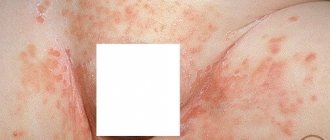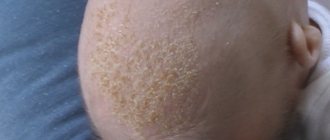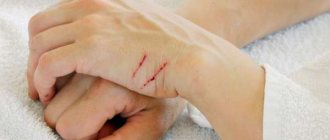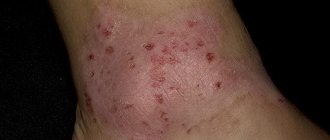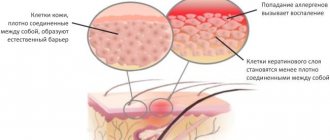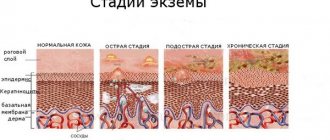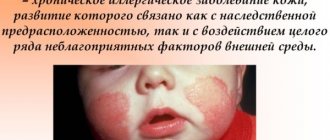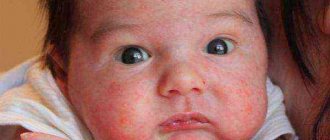Symptoms
If the baby becomes lethargic and restless, and redness and rashes appear in the pelvic area, then the child may be allergic to diapers
Symptoms of dermatitis from diapers are localized directly at the points of contact with the diaper: on the baby’s bottom, inner thighs, and genital area.
Main signs of irritation:
- Redness of the skin.
- Swelling, slight swelling of the skin.
- Rash, blisters.
- Peeling.
- The appearance of eczema, ulcers, wounds.
A baby suffering from this reaction becomes capricious, lethargic, and often cries. If the child is already more than 7 months old, he may point to the sore spot, reporting unpleasant sensations. Sometimes children experience a slight increase in temperature.
On a note! If a rash or redness appears on other parts of the child’s body, this is no longer irritation from the diaper, but some kind of disease or extensive allergy.
Causes
Rash and redness from a diaper usually occur for a trivial reason - the diaper does not allow air to pass through well. The baby does “his business” in it, the diaper gets wet, the moisture remains inside and a greenhouse effect is created. In addition to the fact that the baby’s delicate skin does not breathe, it remains in contact for a long time with toxic substances contained in urine and feces.
Wearing a diaper should alternate with air baths so that the baby’s skin can breathe
Constantly wearing diapers reduces the protective properties of the epidermis and, as a result, severe irritation appears.
Diaper dermatitis can also be caused by:
- Poor hygiene (the parent does not change the diaper often enough, does not clean the baby’s skin when changing).
- Incorrectly selected skincare products (creams, oils, powders).
- No breaks in wearing diapers.
- Poor quality diapers.
- Wrong size (if the diaper is too small, it will squeeze and rub the skin).
- Allergy to any component included in the diaper.
But there are other factors that can provoke dermatitis in a child in the genital area:
- Fungal infections. Most often, infants are affected by the yeast fungus Candida. At first it appears as a normal irritation, then it acquires a characteristic symptom - a white coating and a weeping state of the epidermis.
- Bacterial infections. The most common are staphylococci and streptococci. They are characterized by the appearance of redness, blisters that burst and turn into ulcers, erosion with suppuration.
Infectious dermatitis differs from irritations in that the symptoms increase quickly, the condition of the skin noticeably worsens, and the manifestations may extend beyond the diaper-wearing area.
Every time you change diapers, you must clean your baby's skin.
Diaper dermatitis - symptoms and treatment
The prognosis is favorable. In the vast majority of cases, the disease is not dangerous and, as a rule, does not require specific medications. It usually goes away on its own after stopping the use of diapers and performing proper skin care [18].
To prevent diaper dermatitis, a set of measures is used: ABCDE (abbreviation for English words):
- A - air (air);
- B—barrier;
- C - cleansing (cleansing);
- D - diapering (diaper changing)
- E - education (training).
Air - air . This means frequent air baths when the child is not wearing a diaper. It is recommended to carry out air baths for at least 5-10 minutes when changing a diaper [19].
Barrier - barrier . Use of protective creams. Their application is necessary every time you change diapers. Most often they contain zinc, dexpanthenol, petroleum jelly, and lanolin. These creams create a protective film that separates the skin from the irritating effects of urine and feces.
Cleansing - cleansing . If the skin in the diaper area is inflamed, a daily bath will help remove irritants and reduce the risk of fungal and bacterial infections. Cleaning is carried out with water, it should be gentle, you can use cotton balls or cotton cloth. Baby wipes should only be used on intact skin. They should not contain parabens, alcohol, fragrances, irritants or allergens, and the pH should be neutral. After bathing, you need to gently pat your skin with a towel, avoiding friction [20].
Diapering - changing diapers . Diapers should be changed every 2 hours (every hour for newborns) or after each bowel movement or urination. It is better to choose a diaper with high absorbency. The better the diaper absorbs, the better it keeps the skin dry. Although there is currently no data showing which type of diaper is best for preventing diaper rash, cloth diapers are generally less absorbent than most disposable diapers. If a child develops diaper dermatitis while using cloth diapers, then it is better to switch to disposable diapers during the illness. You need to make sure that the diaper is not too tight, especially when worn at night. A loose diaper will rub less against your skin. Let your baby's skin dry completely before putting on a new diaper. It is also important to prevent the sticky pads from sticking to your baby's skin. Hands should be washed before and after changing diapers to prevent the spread of germs that have caused infection on the baby's skin [21].
Education - training . Educating parents on proper child care is important. It is necessary to provide them with clear instructions regarding daily skin care and information about which skin care products are beneficial and which may be harmful [22].
Treatment
Having discovered unpleasant symptoms in her child, any mother wonders what to do? The first step is to contact your pediatrician. The doctor must find out what caused the dermatitis and only then select the appropriate treatment.
To make an accurate diagnosis, a scraping is taken from the affected area of the body. Additionally, blood, urine, and stool tests may be prescribed.
Treatment of allergic dermatitis
If irritation from diapers is caused by an individual reaction of the child’s body to the constituent materials, then first of all the allergen is removed. Parents should get rid of diapers to which the baby is allergic and choose others.
Depending on the severity of the allergic reaction, the doctor may prescribe medications for internal use or external use only.
Antihistamines for oral use approved for infants:
Fenistil
- Fenistil (drops) – can be given to children from 1 month.
- Zodak (drops) – allowed from 2 months of age.
- Vibrocil - the drug is indicated from 1 month of life.
Ointments, creams for external use:
- Elidel
- Desitin
- Gistan
- Fenistil
These medications are approved for infants. They quickly relieve skin allergy symptoms, eliminate pain, itching, and flaking.
On a note! Very often, the baby’s skin becomes more sensitive during the period of introducing complementary foods. Completely new food enters the body, and it takes time for it to adapt.
Treatment of infectious dermatitis
When the rash under the diaper turns out to be the result of a bacterial infection, antibiotic ointments and antiseptic solutions for wiping the skin are used for treatment.
It is necessary to give a child an oral antibiotic only as a last resort, when the disease is accompanied by a high fever or progresses too quickly.
During treatment you should stop wearing diapers.
Infections in children caused by pathogenic bacteria can be treated with the following topical medications:
- Lincomycin ointment.
- Levomekol.
- Tetracycline ointment.
- Syntomycin ointment.
- Bacitracin.
- Miramistin.
- Erythromycin ointment.
- Chloramphenicol.
Before applying the product, the baby’s skin is treated with an antiseptic solution without alcohol: Furacilin, Chlorhexidine, manganese diluted in water. During treatment you should stop wearing diapers.
Important! Do not self-medicate or use antibiotics without a doctor's prescription.
How to treat fungal dermatitis
Epidermal irritation caused by fungal parasites is easily treatable at the initial stage. Antifungal creams and ointments are used to suppress mycosis.
Antimycotic drugs that infants can use:
- Clotrimazole
- Fluconazole
- Lamisil
Before application, the skin must be washed with soap and dried.
When the infection is advanced, antimycotic drugs are additionally prescribed for oral administration.
Treatment of contact dermatitis
Common diaper irritation caused by contact with non-breathable material and toxins from feces can be treated with creams/ointments aimed at skin regeneration.
Bepanten cream helps perfectly with all types of dermatitis
The most effective drugs:
- Bepanten (Panthenol, Pantenstin) - quickly heals damaged epidermis, eliminates itching and redness. These are the best creams for babies.
- Zinc ointment is an inexpensive medicine that has an effective therapeutic effect. Relieves symptoms of irritation, has an antibacterial effect, reduces sweating.
- Sudocrem - designed specifically for newborns, prevents diaper rash, prickly heat and other negative signs on the skin.
- Adavant - ointment treats contact and other types of dermatitis, relieves inflammation, and regenerates tissue.
- La-Cri is a good remedy for diaper rash and redness.
- Canocan - quickly eliminates the symptoms of diaper rash in babies, dermatitis and other irritations.
Important! Under no circumstances use alcohol-containing antiseptics, especially iodine and brilliant green, for treatment.
How to treat
- The most important thing is not to start the problem, to start treatment on time. Change diapers more often, do not skimp, preferably every 2 to 4 hours. Don't wait until the diaper is full;
- Wash your baby thoroughly when changing diapers. Put on the diaper after thoroughly drying the bottom and groin areas. At the same time, do not wipe, but carefully blot the affected areas with a towel. You can use baby powder (if the skin needs to be additionally dried) or cream (See about using special creams for diapers >>>);
- When treating diaper dermatitis and for its prevention, give your baby air baths. Do them as often as possible, three to four times a day, let the baby’s skin rest from the diaper and breathe. The duration of the air bath is about 20 minutes, the temperature in the room is preferably about +23 degrees;
- Choose the right diaper size. If you see red stripes on your baby’s skin from the edges of the diaper, immediately change it to a larger size. It is easier to change a diaper than to treat the irritation that appears;
- You can use special creams, applying them after bathing the baby (Bepanten, Drapolen, Destin, d - Panthenol and others) .
Traditional methods
- When bathing, it is good to add decoctions of string herbs and chamomile to the water; they relieve itching and irritation. Boil 5 tbsp. l. herbs in two liters of boiling water, let the broth brew, mix with water prepared for bathing the baby;
- If you don’t have baby powder at home, you can take equal parts of starch and streptocide tablets, previously crushed into powder. This homemade powder dries well and has antibacterial properties.
All these measures provide quick treatment of diaper dermatitis.
When to see a doctor
- If the irritation does not go away after three days. The doctor will examine the baby and prescribe a special ointment;
- If all the steps taken do not help, the redness not only does not go away, but also intensifies, itching, swelling appears, the baby is worried, capricious, immediately consult a dermatologist. Most likely, a candidiasis infection has been added to the diaper dermatitis, and it requires drug treatment.
Traditional methods
Skin reactions to diapers can also be cured using folk recipes. Such methods are as safe as possible, but do not always give quick results.
Herbs
- Herbs: sage, chamomile, calendula have wound-healing, bactericidal, regenerating properties.
A decoction of medicinal herbs should be used to wipe the rash areas.
A strong decoction is prepared from these plants (take 1 teaspoon of each herb and pour 300 ml of boiling water, leave for 3 hours), and wipe the baby’s skin with it 4-6 times a day.
- The allergic reaction will quickly be relieved by the herb. Two tsp. dry plant is brewed with a glass of boiling water. After 3 hours, filter the infusion and rub throughout the day. The redness goes away very quickly.
- Oak bark is an excellent remedy for diaper rash, dermatitis, and irritation. It contains a large amount of tannins, which quickly treat such problems.
One tbsp. pour a spoonful of bark into a glass of boiling water and leave for 2 hours. The liquid is filtered and the affected area is wiped with it up to 7 times a day.
Medicinal oil
Olive oil (300-400 ml) is used as a basis. It is poured into a container, placed on low heat and added 1 tsp. herbs of succession, yarrow, sage, chamomile. The oil should boil for 15-20 minutes, then it should sit for a day. Afterwards, filter and pour into a clean glass bottle.
The resulting herbal oil is used to treat diaper rash and irritation in a child 3-4 times a day.
Important! Any herb runs the risk of becoming an allergen for the delicate and sensitive skin of children. When applying folk measures, carefully monitor the reaction. Each such recipe can cure, but it can also harm.
